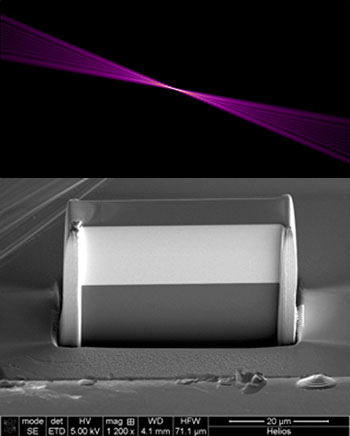
(Top) Artist’s reconstruction of focused X-ray beam, which reached 8 nm at the waist area. (Bottom) The focusing lens, 40 μm in width, consists of 5,500 alternating layers of tungsten and silicon carbide (white zone) deposited on a flat substrate (dark zone). [Images: Saša Bajt/DESY]
As anyone who’s had a broken bone can testify, X-rays are excellent vehicles for penetrating matter—and their very short wavelengths (0.1 to 1 nm) make them great candidates for imaging the nanoworld. But those same characteristics have made hard X-ray beams tough to focus down to the spatial resolution required for taking nanoscale imaging to the next level.
A team of European and U.S. scientists has now developed a new method for fabricating lenses that can focus a hard synchrotron X-ray beam down to a spot of around 8 nm, comparable to the focusing performance of much more expensive, difficult-to-fabricate curved mirrors (Sci. Rep., doi: 10.1038/srep09892). While a number of technical issues remain to be resolved, the study’s authors believe the method could provide a path toward lenses that focus at single-nanometer resolution.
Technical challenge
The challenge of focusing X-ray beams at high resolutions lies in their very short wavelengths, which require very large numerical apertures to achieve the desired nanometer-scale focus. Because of their penetrating power, the rays pass through conventional optical lenses essentially unaffected. The current, state-of-the-art method for focusing X-rays—reflecting the beam at “grazing” incidence off a curved mirror—has achieved focus on the order of 7 nm, but requires relatively large mirror surfaces that must be polished to nanometer accuracy, an expensive proposition.
An alternative and potentially much cheaper approach, known as a multilayer Laue lens (MLL), has been on the table for many years, but has faced some formidable technical roadblocks for the X-ray scale. This method involves the creation of artificial crystals through deposition of multiple layers of material at slightly varying angles, to maximize the area of the lens that satisfies Bragg’s law and thus can focus an incident incoherent beam. Making matters even more difficult, the nanometer-thin spacing of the layers must follow an additional restriction called the zone-plate condition, which ensures that the elements of the focused beam interfere constructively at the focal point. Meeting both criteria experimentally, at the requisite precision, has thus far proved impossible.
Deposition “in the shade”
To push toward MLLs for focusing hard X-ray beams, a team led by Saša Bajt at the Deutsches Elektronen-Synchrotron (DESY) facility in Hamburg, Germany, developed a new method for fabricating the lenses. The approach involved building up alternating layers of silicon carbide (SiC) and tungsten (W) onto a flat substrate via magnetron sputtering. The substrate was partially shadowed by a straight-edged mask (penumbra), which allowed the team to control and change the deposition rate using a carefully calculated function varying with distance perpendicular to the mask edge. The resulting “wedged MLL” was then sliced out of the penumbra region.
Using this method, the team built up a lens consisting of 5,500 alternating layers tuned to meet the Bragg and zone-plate conditions. The lens was then used to focus an X-ray beam from the DESY synchrotron to a focus just 8 nm in width. Additional tests to characterize the beam, including ptychographic interferometry, showed that the lens transmitted up to 60 percent of the incident beam energy, with a uniform intensity profile.
Some work remains to get the spot size down to below 8 nm. But Bajt believes that the method offers sufficient control for still higher-power X-ray lenses. “It appears,” she concludes, “that the long-sought goal of focusing X-rays to a nanometer is in reach.”
